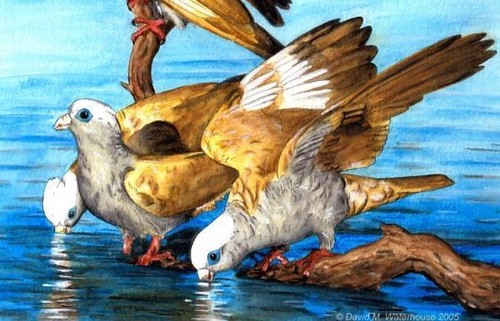Parrot Fossil 55 Million Years Old Discovered In Scandinavia
 Saturday, May 17, 2008 at 11:44
Saturday, May 17, 2008 at 11:44  Artists impression of the parrot-like bird 'Mopsitta tanta' dating back 55 million years. The fossils indicate that parrots once flew wild over what is now Norway and Denmark. Credit: Dr David Waterhouse.Palaeontologists have discovered fossil remains in Scandinavia of parrots dating back 55 million years. Reported May 14 in the journal Palaeontology, the fossils indicate that parrots once flew wild over what is now Norway and Denmark.
Artists impression of the parrot-like bird 'Mopsitta tanta' dating back 55 million years. The fossils indicate that parrots once flew wild over what is now Norway and Denmark. Credit: Dr David Waterhouse.Palaeontologists have discovered fossil remains in Scandinavia of parrots dating back 55 million years. Reported May 14 in the journal Palaeontology, the fossils indicate that parrots once flew wild over what is now Norway and Denmark.
Parrots today live only in the tropics and southern hemisphere, but this new research suggests that they first evolved in the North, much earlier than had been thought.
The fossil parrot was discovered on the Isle of Mors in the northwest of Denmark – far from where you’d normally expect to find a parrot. It’s a new species, officially named 'Mopsitta tanta'. However, already its nick-name is the ‘Danish Blue Parrot’, a term derived from a famous comedy sketch about a 'Norwegian Blue Parrot' in the 1970s BBC television programme ‘Monty Python’.
The Scandinavian connection makes links to Monty Python’s notoriously demised bird irresistible, but the parallels go further. The famous sketch revolves around establishing that a bird purchased by John Cleese is a dead parrot, and in dealing with these fossils, palaeontologists were faced with the same problem.
As Dr David Waterhouse, lead author of the paper, explains: “Obviously, we are dealing with a bird that is bereft of life, but the tricky bit is establishing that it was a parrot. As with many fragile bird fossils, it is a wonder that anything remains at all, and all that remains of this early Danish parrot is a single upper wing bone (humerus). But, this small bone contains characteristic features that show that it is clearly from a member of the parrot family, about the size of a Yellow-crested Cockatoo.”
Dr David Waterhouse was funded by a UCD postgraduate scholarship from 2002 to 2006. He is currently Assistant Curator of Natural History at Norfolk Museums Service. Dr Bent Lindow was an IRCSET ‘Basic Research Grant’ scholar at UCD and the University of Copenhagen from 2004 to 2007. He is currently postdoctoral researcher in palaeontology at the Natural History Museum of Denmark in Copenhagen.
At around 55 million years old, this is very much an ex-parrot. Indeed, Mopsitta represents the oldest and most northerly convincing remains of a parrot ever to have been discovered.
Waterhouse continues: “It isn’t as unbelievable as you might at first think that a parrot was found so far north. When Mopsitta was alive, most of Northern Europe was experiencing a warm period, with a large shallow tropical lagoon covering much of Germany, South East England and Denmark. We have to remember that this was only 10 million years after the dinosaurs were wiped out, and some strange things were happening with animal life all over the planet.”
“No Southern Hemisphere fossil parrot has been found older than about 15 million years old, so this new evidence suggests that parrots evolved right here in the Northern Hemisphere before diversifying further South in the tropics later on.”
So was Danish Mopsitta “pinin’ for the fjords”? “It’s a lovely image,” says Waterhouse, “but we can say with certainty that it was not. This parrot shuffled off its mortal coil around 55 million years ago, but the fjords of Norway were formed during the last ice age and are less than a million years old.”
This research was supported by the Irish Research Council for Science, Engineering and Technology (IRCSET) and University College Dublin (UCD).
 Mopsitta tanta - Danish Blue Parrot | in
Mopsitta tanta - Danish Blue Parrot | in  (Re-)discovery,
(Re-)discovery,  Evolution,
Evolution,  Oddities
Oddities 
